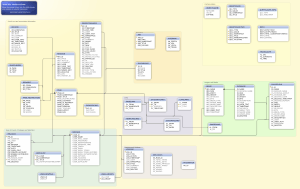Database schema facts for kids
A database schema is like a master plan or a blueprint for a database. Think of it as the detailed design that shows how all the information in a database is organized. It describes the structure of the database using a special language that computers understand. This plan doesn't contain any actual information, but it shows where everything will go.
A database schema also includes important rules called integrity constraints. These rules make sure that only correct and valid information can be added to the database. If you try to put in data that breaks these rules, the database won't accept it. All these rules are written in the same computer language.
Contents
Understanding Database Schemas
A database schema helps a database management system (DBMS) know exactly how to store and manage data. It's like the architect's drawing for a building. The drawing shows where the walls, rooms, and doors are, but it doesn't show the furniture or people inside.
Different Kinds of Schemas
There are usually three main types of database schemas, each looking at the database from a different angle:
- The conceptual schema is the big picture. It shows the main ideas and how they connect. For example, it might show that "students" have "classes" and "teachers."
- The logical schema is more detailed. It maps out specific things like "student ID numbers" or "class names" and how they relate. It's like drawing out the exact rooms and their sizes.
- The physical schema describes how the database is actually built on the computer. It deals with technical details like how the data is stored on hard drives. This is like deciding what materials (wood, brick, glass) will be used to build the rooms.
What Makes a Good Schema?
An ideal database schema should have a few important qualities to work well:
- It should be complete: This means it includes all the necessary information from the original source. Nothing important should be left out.
- It should be minimal: The schema should be as simple as possible without losing any important details. You shouldn't be able to remove any part of it without losing information.
- It should be normalized: This is a fancy way of saying that each piece of information should only appear once in the schema. This helps prevent mistakes and makes the database more efficient.
See also
 In Spanish: Esquema de una base de datos para niños
In Spanish: Esquema de una base de datos para niños


